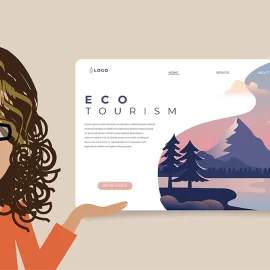
16 Tips for a Better Website
Want a better website and don’t know where to start? Do you think your website changes are out of your control? Many website owners think a better website means a complete overhaul – a brand new website. In some cases, that may be true but a couple tweaks can make the difference between bland and beautiful.
Here are 16 ideas you can put into action right now.
1. Condense your navigation menu
Do you have 12 items under one heading on your navigation bar? If so, you might want to look at tidying it up.
A cleaner navigation makes things easier to find. When things are easier to find, it creates a better experience for your website’s visitors. Plus, they’ll be less likely to hit the back button because they won’t be frustrated trying to find what they need.
2. Have a call to action on every webpage
Every webpage on your website should be making your visitor act on something. Maybe it’s to get them to purchase your e-book, view your credentials or watch a demo video. Whatever it is, make it known to the user.
Remember, they don’t want to think when they’re browsing your website. Whether it’s a button or a hyperlink, something on every webpage should lead them to the action you ultimately want them to take.
3. Put your phone number on your homepage
Every website should have their phone number. Seems obvious, right? But many don’t. It’s often buried on a contact page or not on the website at all. Big mistake!
Many visitors head to your website just to find your phone number. So make it prominent on your homepage. The top right corner is usually best or down in the footer. Regardless, put it up there!
4. Add business hours
Similar to the phone number, when is your business open? Can someone call you at 6am? What if someone is bringing their parents to your restaurant and it’s 10pm? Will they be able to eat?
These questions are inside the head of your customers more than you think. Making your hours known solves this. So put them up for all to see.
5. Add an About page
Who are you? Do you work with a big team? When a business person or consumer selects a company to do business with, they often like to know who they’ll be working with.
Add pictures of your team with real bios. Sure, professional experience is awesome, but list your hobbies, family life and things you like to do for fun. Bottom line, show you’re a real human being.
6. Use big, bold images
This seems to be a pretty big trend in web design, but it’s because images speak louder than words.
Capture your visitors with beautiful imagery. Take pictures of your team in action, shots of the local area or recent projects you’ve worked on.
7. Add a directions widget
Directions are convenient for just about anybody. Google has a free map widget you can add to your website. Just enter your address and you’ve got directions right to your front door. It shows prospective customers you care about the whole experience.
8. Make your website mobile friendly
Your new customers are most likely to come from mobile browsing. But, it’s tough to navigate a website that’s not optimised for a tiny screen.
There are plenty of inexpensive tools to create a mobile website from your current website. Explore those or get a designer to make your website mobile friendly.
9. Match your company branding
Did you just update your logo or change your company colours? Make sure your brick and mortar experience matches your online experience. It helps to create brand awareness, so customers recognise your company when they’re on the road or describing it to others.
10. Cut the distractions
Do you have Frank Sinatra playing on your website or a splash page that blocks people from getting to what they need? Remove it all. Why? Not only is it annoying for many visitors but it distracts them from doing what you want them to do.
11. Get social with your customers
Haven’t hopped on social media yet? These days, it seems like the entire world is on social media in some way or another. We’re social people who like to interact with friends, family members and even strangers. Plus, we listen to their recommendations. You want in on this community building.
Get started with a Facebook page or Instagram account and focus on mastering one of them. Then move to the next network.
12. Add industry resources
Want to establish yourself as the company to go to in the industry? Then add some resources to your website. This could be reports, surveys, white papers or helpful links. This material demonstrates to prospective customers you know your stuff. So, get writing!
13. Add testimonials
Your current customers are a huge asset to your company because they can provide real world case studies and testimonials as to how your company has helped them save time, save money, etc. Reach out to your best customers and ask for a testimonial.
Here’s a tip. Have it pre-written, so all your customer has to do is approve it.
14. Figure out your website’s main goal
Why do you have a website? What do you want your website to do?
After you figure out these two questions, make sure your website accomplishes the goal by adding or deleting pages, restructuring your website, making a new landing page, etc. Make your goal a top priority and let your team know what that goal is, so they can help out too.
15. Start from scratch
While this isn’t recommended because it takes a lot of time, money and resources, it may be worth it.
If you’ve got an old website, starting over with brand new technology would be smart, rather than trying to patch what you already have. Start with a pencil sketch of what you want and assemble the best team to make it happen.
16. Hire a professional
If you’ve kept your web work in-house, it may be worth looking at bringing in the big guns. They’ll not only move the project forward but they’ll bring their own experience and expertise to the project.
SOURCE: Web Design Ledger
Need a professional looking website?



